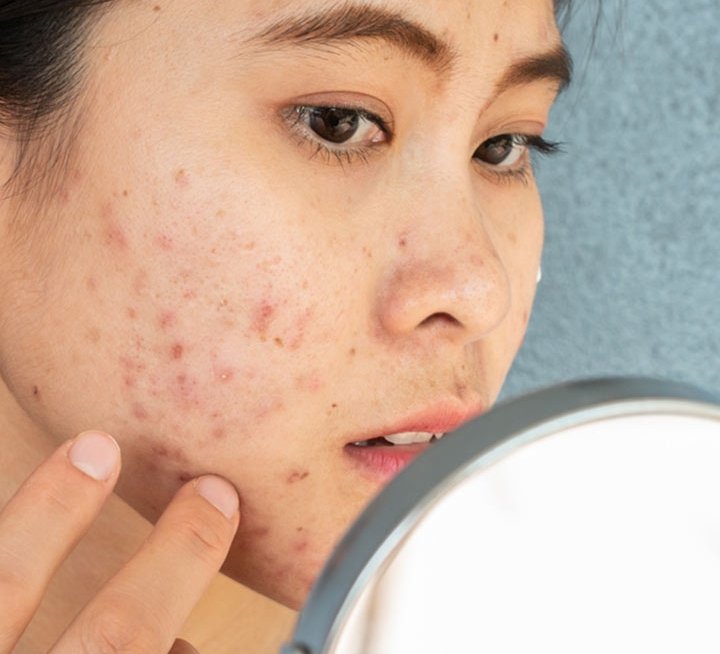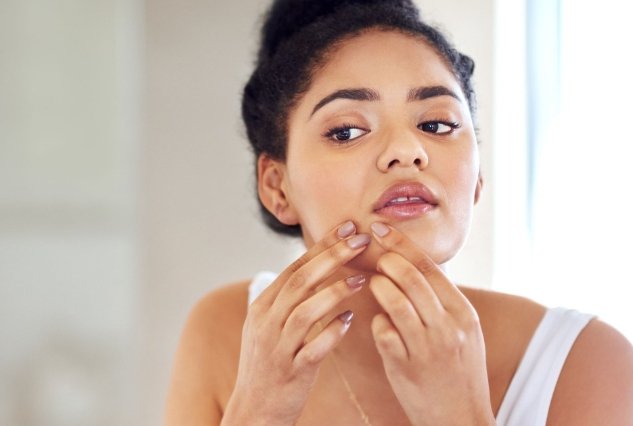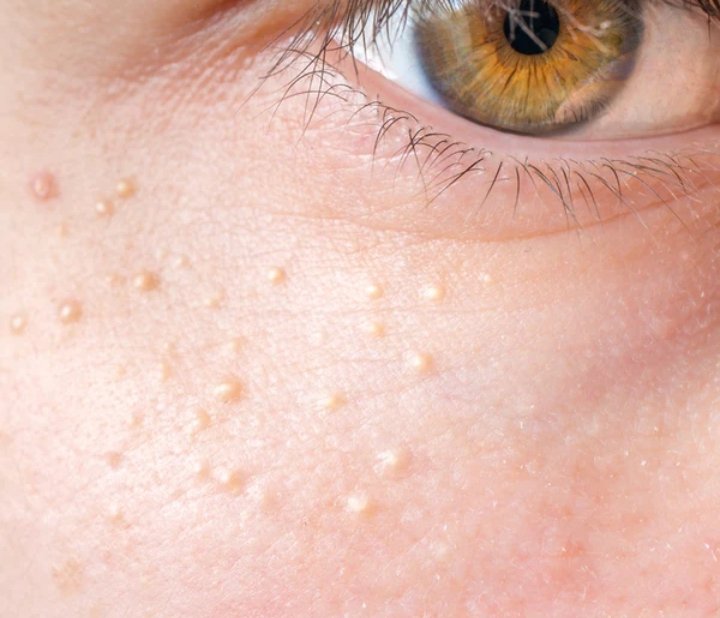Those small raised bumps – could it be fungal acne or whiteheads? What is that and what really is the difference?.
Let’s see if we can help figure this out with you. If you’re unsure about how to spot between whiteheads, milia and fungal acne, then read on to see how you can self diagnose and treat your skin properly!.
Fungal Acne.

Fungal acne is a type of infection in your skin’s hair follicles. It most commonly appears as small pimples that don’t vary much in shape or size, often along with itching.
Fungal acne can cause whiteheads and skin irritation. It’s often confused for acne vulgaris. This is the type of acne most commonly associated with blackheads and whiteheads.
But fungal acne and acne vulgaris are two different conditions caused by two different things. They won’t respond to the same treatment. If you keep using anti-acne treatments, you can make fungal acne worse.
That’s why it’s important to understand what fungal acne looks like and how it develops. Read on to learn the symptoms and signs of fungal acne and what you can do to treat and prevent breakouts.
What are the causes of fungal acne?.
Fungal acne is a bit of a misnomer. Unlike acne, fungal acne isn’t caused primarily by oil and bacteria in pores, although oil and sebum production are a big part of helping feed the bacteria that cause fungal acne.
Instead, the pimple-like bumps and irritated skin associated with fungal acne are caused by an overgrowth of yeast, a type of fungus.
That’s why it’s sometimes called fungal acne. It’s also referred to as Pityrosporumfolliculitisor Malasseziafolliculitis.
The yeast responsible for fungal acne is always present on your skin. Typically, your body is able to balance the yeast, other fungi, and bacteria that are also a part of your skin.
But if that natural balance is upset, an overgrowth can occur. That’s when the infection of hair follicles develops and acne-like symptoms show up.
Several conditions or events can upset this balance of bacteria and fungi, including:
- Trapped moisture.Wearing sweaty workout clothes for too long can encourage yeast growth. Rewearing workout clothes without washing them may also expose your skin to fungi that have grown in the clothes.
- Medication.If you take antibiotics, the bacteria on your skin can be reduced. That can allow for the overgrowth of a fungus.
- Suppressed immune system. People with compromised immune systems may be more likely to develop fungal acne.
- Diet changes. Fungi and yeast feed on carbohydrates, so balancing your intake of sweets and carb-rich foods may help slow fungal growth.
- Wearing tight clothes. Regularly wearing non breathable clothes can encourage extra sweat and moisture. This can foster a skin environment ripe for yeast growth.
- Warm, moist environments.People living in hot climates, where sweating is more likely, may experience fungal acne more frequently.
What are the symptoms of fungal acne?.
One of the reasons fungal acne can last for so long is because fungal acne looks similar to acne vulgaris, or bacterial acne.
People with fungal acne, not knowing the difference, may treat it with regular acne skin care options. These treatments don’t work, and they can make the infection worse.
Here’s how to tell the difference between fungal acne and bacterial acne:
- Size.Pus-filled bumps caused by fungal acne tend to be nearly all the same size. Bacterial acne can cause pimples and whiteheads of varying sizes.
- Location. Fungal acne often shows up on the arms, chest, and back. It can also be on the face, where bacterial acne is most common.
- Itching.Fungal acne often causes itchiness. Bacterial acne rarely does.
- Clusters. Fungal acne often appears in clusters of small whiteheads. Bacterial acne is less clustered and more sparse.
Fungal acne is the result of yeast growth, so you may experience other yeast-related conditions, like psoriasisand dandruff. This can help you determine whether your breakouts are from yeast or another cause.
How can I prevent fungal acne?.
While fungal acne can’t be prevented completely, these steps may help reduce the chances of a return infection:
- Use a dandruff shampoo regularly.This regular rinse may help maintain a healthy balance of yeast on your skin. Once the breakout is gone, you can cut back on how often you use the shampoo as a body wash to as little as once a week.
- Wear breathable fabrics. Breathable fabrics allow for airflow, which can cut down on warm, moist environments that encourage fungus growth. If changing your clothing options helps treat fungal acne, consider wearing similar types of clothing.
- Shower after sweating.A quick rinse after a workout or sweaty day at work can help prevent yeast growth issues.
- Eat a balanced diet. Fungi like yeast thrive on sugary carbohydrates, so balance your diet with fruits, vegetables, and proteins to help discourage overgrowth.
Treating Fungal Acne.
Fungal acne is often treated improperly because it looks a lot like regular acne. Many people use everyday anti-acne treatments against it, but those won’t work.
To properly treat the fungal infection, you need to restore the balance between yeast and bacteria on the skin.
Fungal acne is a type of infection in hair follicles caused by an overgrowth of yeast. Despite the name, it’s not like the acne that causes whiteheads and blackheads.
Typical anti-acne treatments won’t work for fungal acne. Instead, you need to identify this type of infection accurately in order to properly treat it.
Learning how to identify this specific type of skin infection can also help you prevent future breakouts.
What Are Milia?.

Milia are tiny white bumps (pimples or cysts) on your skin. They most often happen on infants’ faces. But anyone can get them on any part of the body.
You may hear milia (one is a milium) referred to as milk spots or oil seeds. It’s a common blemish that affects 40% to 50% of newborns.
Symptoms of Milia.
Milia look like small white bumps on the cheeks, chin, or nose. They can also be on the body, especially the trunk and limbs.
Milia don’t cause problems. They aren’t painful or itchy. Worsening symptoms such as inflammation, pain, or leakage may be signs of acne.
Causes and Risk Factors of Milia.
Your body sheds dead skin cells to make way for fresh new ones.
Milia happen when the dead skin cells don’t slough away. Instead, they get caught under the new skin, harden, and form a milium.
Milia can also happen because of:
- Skin damage from something like a rash, an injury, or sun exposure
- Long-term use of steroid medications
- Your genes
- An autoimmune condition
Babies are most likely to get milia. Because their skin is still learning how to replace itself, they sometimes have milia and baby acne.
You’re also at higher risk if you:
- Don’t follow proper skin care
- Use cosmetics or makeup that clogs your pores
- Don’t get enough sleep
- Have skin conditions like dandruff, rosacea, or eczema
Treating Milia.
It’s fine to let milia be. They’ll go away on their own after a few weeks or months.
You may be tempted to pick at or pop the milia. This irritation may only make it worse and cause complications. Picking at the skin around the milia can lead to scarring or an infection.



